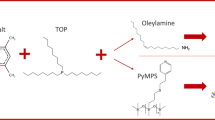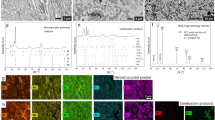Abstract
Ceramics are often prepared with surface layers of different composition from the bulk1,2, in order to impart a specific functionality to the surface or to act as a protective layer for the bulk material3,4. Here we describe a general process by which functional surface layers with a nanometre-scale compositional gradient can be readily formed during the production of bulk ceramic components. The basis of our approach is to incorporate selected low-molecular-mass additives into either the precursor polymer from which the ceramic forms, or the binder polymer used to prepare bulk components from ceramic powders. Thermal treatment of the resulting bodies leads to controlled phase separation (‘bleed out’) of the additives, analogous to the normally undesirable outward loss of low-molecular-mass components from some plastics5,6,7,8,9; subsequent calcination stabilizes the compositionally changed surface region, generating a functional surface layer. This approach is applicable to a wide range of materials and morphologies, and should find use in catalysts, composites and environmental barrier coatings.
This is a preview of subscription content, access via your institution
Access options
Subscribe to this journal
Receive 51 print issues and online access
$199.00 per year
only $3.90 per issue
Buy this article
- Purchase on Springer Link
- Instant access to full article PDF
Prices may be subject to local taxes which are calculated during checkout




Similar content being viewed by others
References
Singh, R. K., Gilbert, D. R., Fitz-Gerald, J., Harkness, S. & Lee, D. G. Engineered interfaces for adherent diamond coatings on larger thermal-expansion coefficient mismatched substrate. Science 272, 396–398 (1996).
Gogotsi, Y. G. & Yoshimura, M. Formation of carbon films on carbides under hydrothermal conditions. Nature 367, 628–630 (1994).
Roy, R. Ceramics by the solution-sol-gel route. Science 238, 1664–1669 (1987).
Besmann, T. M., Sheldon, B. W., Lowden, R. A. & Stinton, D. P. Vapor-phase fabrication and properties of continuous-filament ceramic composites. Science 253, 1104–1109 (1991).
Kerk, S. L., Tay, S. C. & Hu, S. J. Effect of inherent deformations of leadframes on bleedability of plastic dip. J. Electron. Mater. 18 Part 1, 117–121 (1989).
Perovic, A. Morphological instability of poly(ethylene terephthalate) cyclic oligomer crystals. J. Mater. Sci. 20, 1370–1374 (1985).
Perovic, A. & Murti, D. K. The effect of coatings on the surface precipitation of oligomeric crystals in poly(ethylene terephthalate) films. J. Appl. Polym. Sci. 29 Part 2, 4321–4327 (1984).
Needles, H. L., Berns, R. S., Lu, W. C., Alger, K. & Varma, D. S. Effect of nonionic surfactant and heat on selected properties on polyester. J. Appl. Polym. Sci. 25, 1737–1744 (1980).
Perovic, A. & Sundararajan, P. R. Crystallization of cyclic oligomers in commercial poly(ethylene terephthalate) films. Polym. Bull. 6, 277–283 (1982).
Neubrand, A. & Rodel, J. Gradient materials: An overview of a novel concept. Z. Metallkd. 88, 358–371 (1997).
Gladden, L. F. et al. Structural studies of high surface area silicas. J. Non-Cryst. Solids 139, 47–59 (1992).
Dariel, M. P., Levin, L. & Frage, N. Graded ceramic preforms: Various proceeding approaches. Mater. Chem. Phys. 67, 192–198 (2001).
Fischbach, D. B. & Lemoine, P. M. Influence of a CVD carbon coating on the mechanical property stability of nicalon silicon carbide fibre. Composites Sci. Technol. 37, 55–61 (1990).
Li, J. X., Matsuo, Y. & Kimura, S. Improvement of thermal stability of SiC fibre by CVD-C.SiC coating. Bull. Ceram. Soc. Jpn 99, 1207–1211 (1991).
Moya, J. S., Sanchez-Herencia, M. R., Pena, P. & Requena, J. Layered ceramic composites: A new family of advanced materials. Third Euro-Ceramics (eds Durán, P. & Fenández, J. F.) 3, 289–300 (Feenza Editrica Iberica, Spain, 1993).
Sidky, P. S. & Hocking, M. G. Review of inorganic coatings and coating processes for reducing wear and corrosion. Br. Corrosion J. 34, 171–183 (1999).
Somiya, S. (ed.) Hydrothermal Reactions for Materials Science and Engineering (Elsevier, London, 1989).
Varaprasad, D. V., Wade, B., Venkatasubramanian, N., Desai, P. & Abhiraman, A. S. Critical requirements in the formation of continuous ceramic fibre precursors. Ind. J. Fibre Textile Res. 16, 73–82 (1991).
Bhat, D. G., Rebenne, H. E. & Strandberg, C. Analysis of coating interlayer between silicon nitride cutting tools and titanium carbide and titanium nitride coatings. J. Mater. Sci. 26, 4567–4580 (1991).
Takeda, M., Sakamoto, J., Saeki, A., Imai, Y. & Ichikawa, H. High performance silicon carbide fibre Hi-Nicalon for ceramic matrix composites. Ceram. Eng. Sci. Proc. 16, 37–44 (1995).
Ishikawa, T., Kohtoku, Y., Kumagawa, K., Yamamura, T. & Nagasawa, T. High-strength alkali-resistant sintered SiC fibre stable to 2,200 °C. Nature 391, 773–775 (1998).
Yamaoka, H., Harada, Y. & Fujii, T. Inorganic fibre including zirconia and its production process. Japanese patent Application No. 2001-167679 (2001).
Abe, Y., Gunji, T. & Hikita, M. Preparation of SiO2-TiO2 fibres from polytitanosiloxanes. Yogyo_kyokai-shi 94 (12), 1243–1245 (1986).
Shen, L., Tan, B. J., Willis, W. S., Galasso, F. S. & Suib, S. L. Characterization of dip-coated boron nitride on silicon carbide fibres. J. Am. Ceram. Soc. 77, 1011–1016 (1994).
Author information
Authors and Affiliations
Corresponding author
Ethics declarations
Competing interests
The authors declare no competing financial interests.
Rights and permissions
About this article
Cite this article
Ishikawa, T., Yamaoka, H., Harada, Y. et al. A general process for in situ formation of functional surface layers on ceramics. Nature 416, 64–67 (2002). https://doi.org/10.1038/416064a
Received:
Accepted:
Issue Date:
DOI: https://doi.org/10.1038/416064a
This article is cited by
-
UV-C/H2O2 heterogeneous photocatalytic inactivation of coliforms in municipal wastewater in a TiO2/SiO2 fixed bed reactor: a kinetic and statistical approach
Reaction Kinetics, Mechanisms and Catalysis (2018)
-
Synthesis, Ceramic Conversion and Microstructure Analysis of Zirconium Modified Polycarbosilane
Journal of Inorganic and Organometallic Polymers and Materials (2016)
-
Mesoporous silicon carbide nanofibers with in situ embedded carbon for co-catalyst free photocatalytic hydrogen production
Nano Research (2016)
-
Silica-decorated mesoporous TiO2 continuous fibers: preparation, structures and properties
Journal of Sol-Gel Science and Technology (2016)
-
Synthesis of Polyyttriocarbosilane and its Conversion to Yttrium-Containing Ceramic
Journal of Inorganic and Organometallic Polymers and Materials (2012)
Comments
By submitting a comment you agree to abide by our Terms and Community Guidelines. If you find something abusive or that does not comply with our terms or guidelines please flag it as inappropriate.



